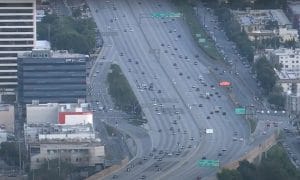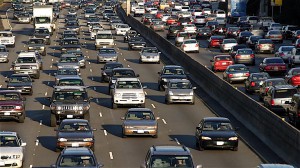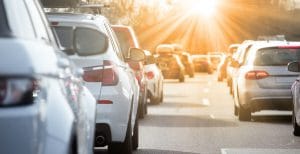
Traffic had uncharacteristically light in the wake of the coronavirus, helping to lower pollution levels in many areas by as much as 30%.
In the days after shelter-in-place orders went into effect in states like California, New York and Michigan, anyone still out on the road might have had a post-apocalyptic experience, traffic on many normally clogged roads like I-405 in Los Angeles all but vanished.
With the vast majority of Americans working from home – if they still had jobs – during the past two months, traffic wasn’t the only thing to vanish. A preliminary report by the National Oceanographic and Atmospheric Administration indicates that air pollution in several parts of the country has diminished by as much as 30%.
How long things will remain that way is uncertain, however. A handful of states have already lifted their lockdowns with most others set to follow within the next month. And, even with many restrictions still technically in place, traffic already appears to be rising in many parts of the country, though it likely will take time to reach pre-pandemic levels.
(Despite lockdowns, Americans still count on their cars to cope with pandemic.)
The COVID Air Quality Study was pulled together to take advantage of one of the rare, positive aspects of the coronavirus pandemic: the fact that millions of vehicles were suddenly taken off the road, eliminating one of the key sources of air pollution.
Targeting the heavily populated Northeast, as well as Denver and the surrounding, high-growth region of Colorado, the study “offers a glimpse into a potential future of urban air quality, due to the ongoing electrification of the U.S. transportation fleet,” NOAA explained.
Researchers have been using a variety of different monitoring systems, including those on the ground, in planes and mounted on satellites, to measure levels of key pollutants including smog-causing oxides of nitrogen, carbon monoxide, greenhouse gases and volatile organic compounds.
Initial data shows that the levels of those pollutants have dropped by anywhere from 25 to 30% since the lockdown began.
The U.S. isn’t the only place where air quality has improved as a result of pandemic-related control measures. “Other parts of the world have also recorded improvements in air quality since the coronavirus outbreak, including the notoriously smog-filled Indian city of New Delhi and industrialized parts of northern China, a thin silver lining to a health crisis that has killed almost 290,000 people,” reported Reuters.
(Silver lining? Coronavirus pandemic slashes traffic, sends gas prices tumbling.)
How long this will last is far from clear. In China, factories across the country have largely started back up again, even in Wuhan, the city where the coronavirus outbreak first was reported. Europe is beginning to open up again, as have several U.S. states, including Georgia. Michigan began allowing manufacturing to resume this week and Detroit’s Big Three automakers all plan to have factories running again on May 18.

Traffic in Los Angeles was down to 44% of normal levels in April, but that number has jumped above 60% in May.
Even with a sizable share of the U.S. still covered by shelter orders, traffic has begun to climb back up. Real-time and historic data provided by navigation service TomTom show levels in L.A. have remained relatively light at peak hours, reaching peak congestion of just 20% during Tuesday’s evening rush hour. That compared with 80% a year ago – but it was still a big increase from mid-April 2020 when there was virtually congestion anywhere or anytime in the LA region.
The Los Angeles Times, meanwhile, found that overall traffic was only 44% of normal levels during the first week of April. But it is now back above 60%.
Detroit roadways are seeing similar increases, as are other cities across the country. On a miles-driven basis, traffic in Seattle was still just 53% of normal at the end of last week, but that was up from just 45% a month earlier.
Those who are starting to get out and about might feel more encouraged to clock some extra miles – not just to shake off their cabin fever but because gas is cheaper than it has been in years. It’s currently averaging $1.86, according to tracking service GasBuddy.com. But the advantage could go to those that fill up soon.
(Empty roads mean faster speeds.)
With the end of a feud between Russia and Saudi Arabia that led to a global petroleum glut, and with increased demand from motorists, gas prices have begun to rise for the first time in months. According to GasBuddy.com, that gallon of self-serve regular now averages seven cents a gallon more across the U.S. than it did just a week ago – though it’s still 99 cents cheaper than it was on May 13, 2019.

